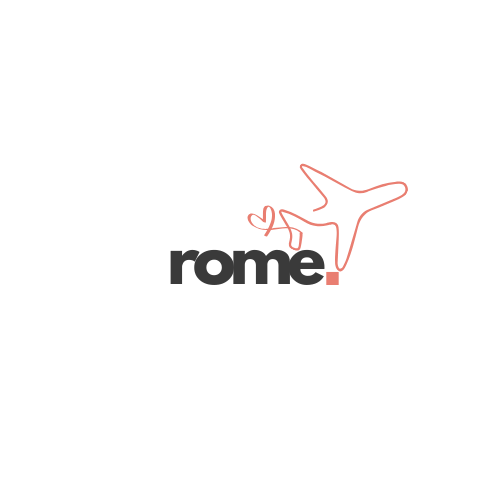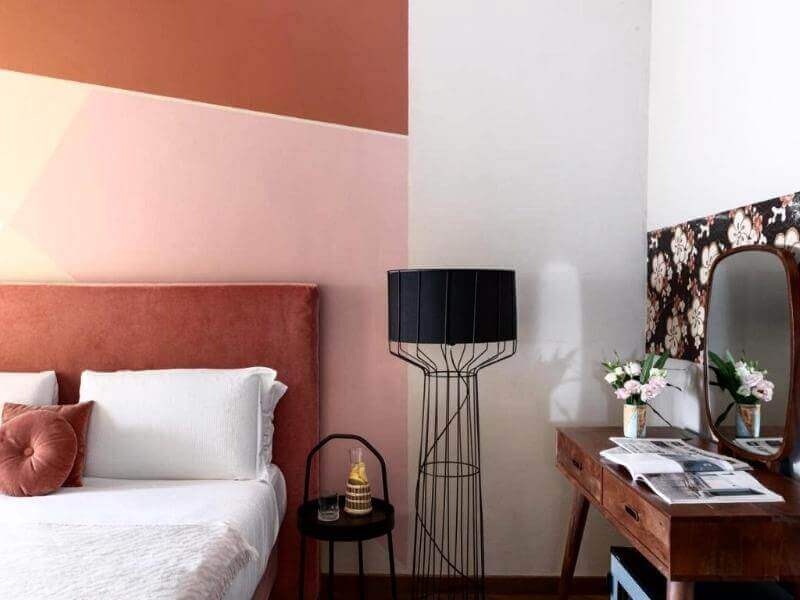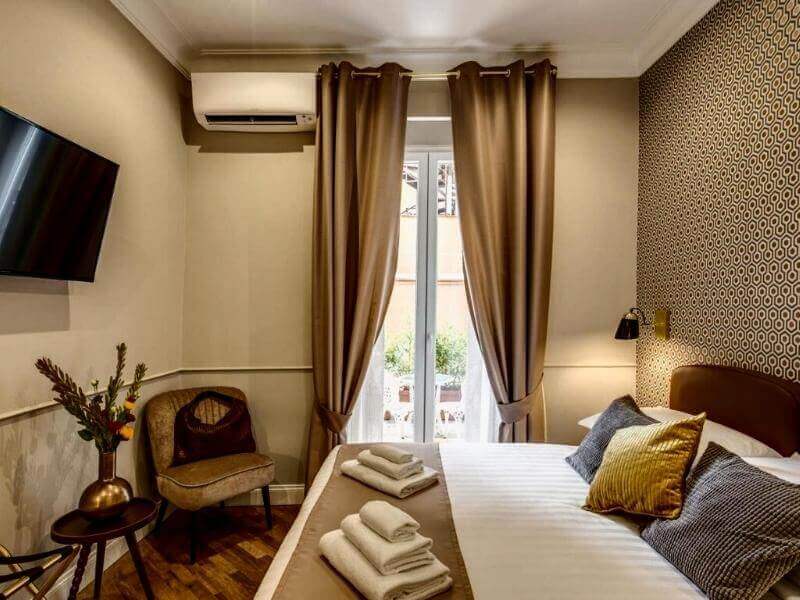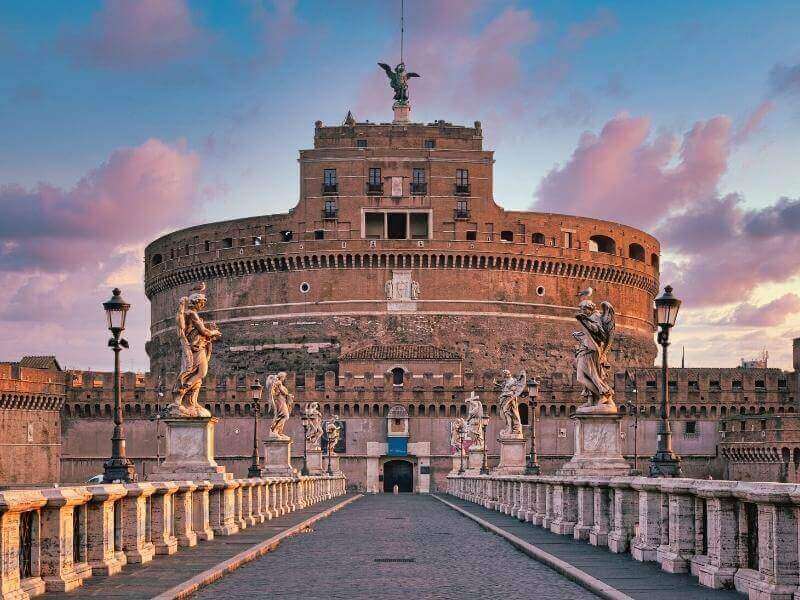Another popular attraction in Rome is Piazza Navona. The baroque-style square was used as a competition arena during the reign of Emperor Titus Flavius Domitian and is still one of the most traditional squares in the eternal city.
In Roman times, the ‘Circus Agonalis,’ which could hold around 30,000 men, was known as the ‘Stadium of Domitian.’ Less than 5 minutes walk from the Pantheon, the Piazza is exceptionally central.
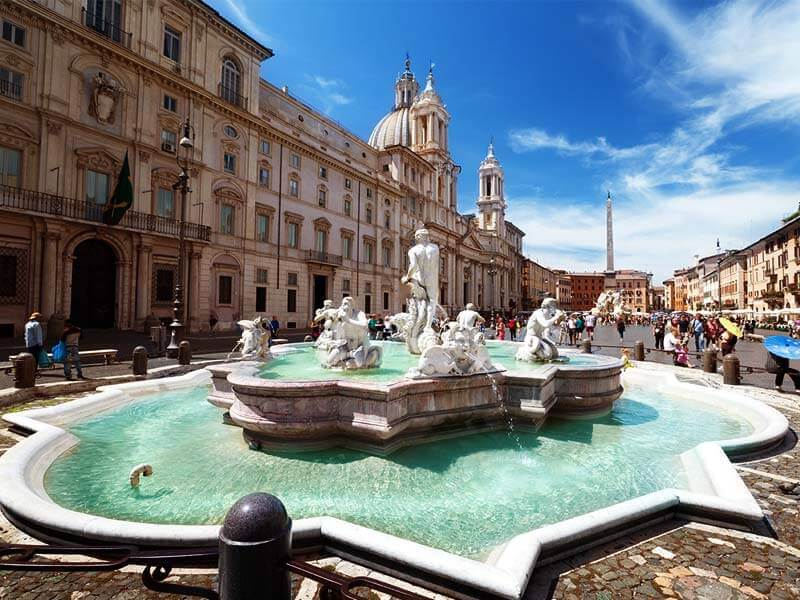
Here, you can visit three of Rome’s most famous baroque fountains and stop off at the numerous pavement cafés and restaurants. Whether at lunchtime or in the evening, Piazza Navona is a hive of activity.
In addition to the many tourists, you will also find lots of street artists here. This is a beautiful place to take a short break, enjoy homemade pasta and a glass of wine, and then have an exclusive portrait drawn of yourself.
Visitor Information:
Address:
Piazza Navona, 00186 Roma
Transportation:
Subway Station Spagna (line A), from there 1.5 km on foot to the piazza
Nearby:
Gladiator Museum (0,1 km)
Pantheon (0,3 km)
Castel Sant Angelo (0,7 km)
Trevi Fountain (0,9 km)
Discover the exciting excavations in Piazza Navona:
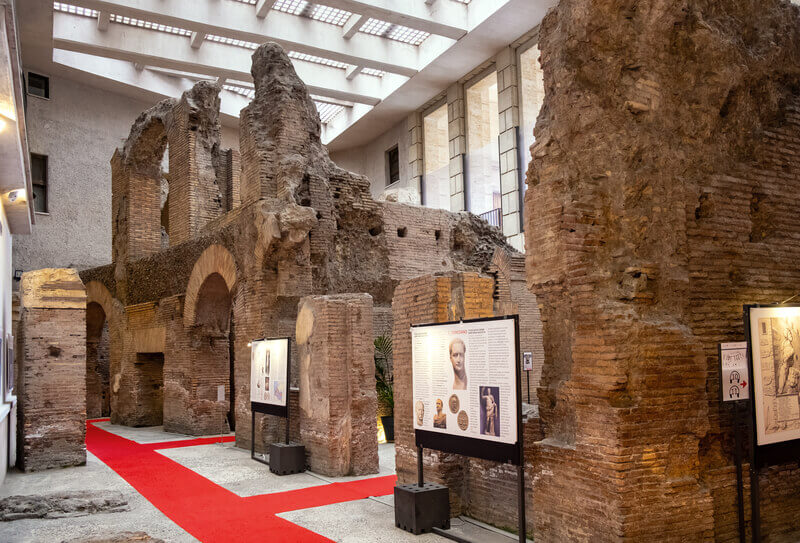
The history of Piazza Navona
Like the Circus Maximus, the Piazza Navona was an important stadium in Roman times. It was provisionally built in 46 BC by Julius Caesar and later completed in 81 – 96 AD under one of Rome’s most industrious builders – Emperor Domitian.
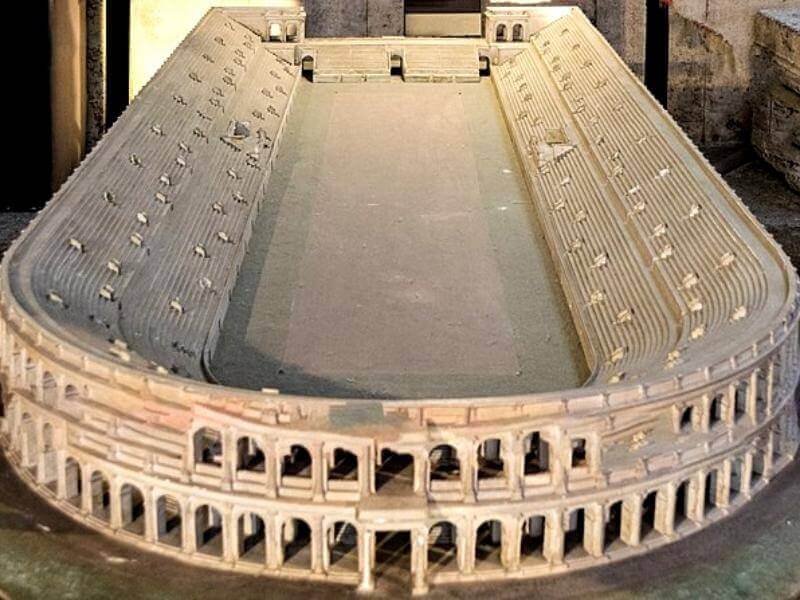
At its height, the arena measured 275 by 106 meters. For comparison, a modern soccer pitch measures 105 by 68 meters!
Initially, this place served as a venue for athletics competitions and chariot races. Later, when the Colosseum was damaged by fire around 217 and thus fell into disuse as a circus for several years, Domitian’s Stadium was even used for gladiator competitions.
In warm summer temperatures, the Romans sometimes blocked the drains so that the entire square could be flooded for their so-called ‘water games.’ The Roman arena was adorned with numerous works of art to decorate it.
The stadium was used for sports and games until the 13th century. It was only with the fall of the Roman Empire that the arena fell into disrepair over the coming centuries.
Like other large buildings, more and more stones were removed over the years and reused for other construction projects.
The former stadium was gradually converted into another of Rome’s market squares until Pope Innocent X finally commissioned the Piazza Navona we know today in the 17th century.
Malicious tongues claim that he may have done this to decorate his palace, the Palazzo Pamphilj, on the opposite side of the street.
Information about Piazza Navona in the video:
Our hotel recommendations in the center of Rome:
Have you already found accommodation?
We have researched the best hotels nearby! -> Hotels in Rome City Center
Guest reviews: 8.7 (Excellent)
The 3 fountains of Piazza Navona
The strikingly elongated shape of Piazza Navona has remained to this day. However, the grandstands, which support almost 30,000 spectators, had to make way for residential buildings over time.
In the 17th century, Pope Innocent also commissioned some great Baroque builders to design a palace, a church, and three characteristic fountains in today’s Parione district.
If you are interested in the archaeological excavations of the Domitian Stadium, you can visit them daily from 10.00 am to 7.00 pm.
About 5 meters below the road surface, you can visit ancient Roman ruins and delve deeper into history. Here you will find all the information you need.

The entrance fee is 8.50 euros for adults. If you have a Rome City Pass, admission is included! Visitors to the excavations also receive multilingual audio guides (German, English, Italian, Spanish, French, and Russian). The last admission is 40 minutes before the end.
The many tombs and altars inside the monument are awe-inspiring. During the 16th century, the Pantheon in Rome also developed into the Church of the Holy Sepulchre. Italian kings and artists, among others, were buried here. The following list shows just a few of these critical personalities.
Fontana dei Quattro Fiumi - the Fountain of the Four Rivers
One of the main attractions of Piazza Navona is the three baroque fountains. The Fontana dei Quattro Fiumi, built between 1649 and 1651 after the ancient “Aqua Virgo” water conduit was extended towards the Piazza, is enthroned in the middle of the Piazza.
Even today, the Four Streams Fountain is still considered a true masterpiece of the High Baroque. The famous Gian Lorenzo Bernini won the architectural tender for the fountain’s construction.
The pompous Baroque fountain was built in honor of the Pope and his Pamphilj family and is considered one of Bernini’s main showpieces.
Further works by the former sculptor can be found today in the Galleria Borghese.
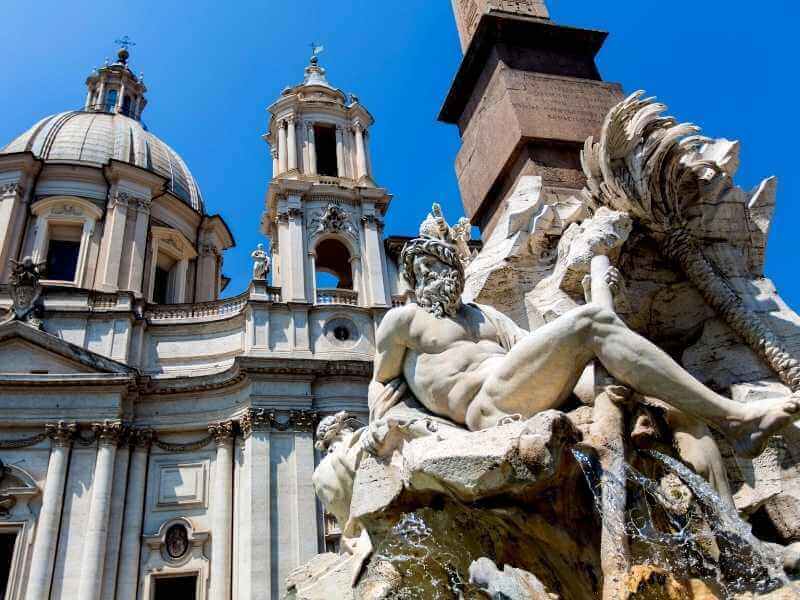
However, the construction of the fountain came at a price. In the 17th century, the immense construction costs almost led to a popular uprising in Rome. Special taxes were levied on bread and other goods to offset the costs of the Fontana dei Fiumi.
The main features of this fountain are its four detailed stone figures. These are intended to represent the Ganges (Asia), the Nile (Africa), the Danube (Europe), and the Río de la Plata (America) – the largest rivers of the four continents known at the time.
The four male figures lie at the feet of a 16.55-meter high obelisk – the ‘Obelisco Agonale’ from the time of Domitian. The considerable obelisk once adorned the Temple of Isis and Serapis, which stood on the Field of Mars.
You will find plants and animals to the side of the Roman fountain. The Pamphilj family’s heraldic animal – the dove – also stands in the middle of the obelisk.
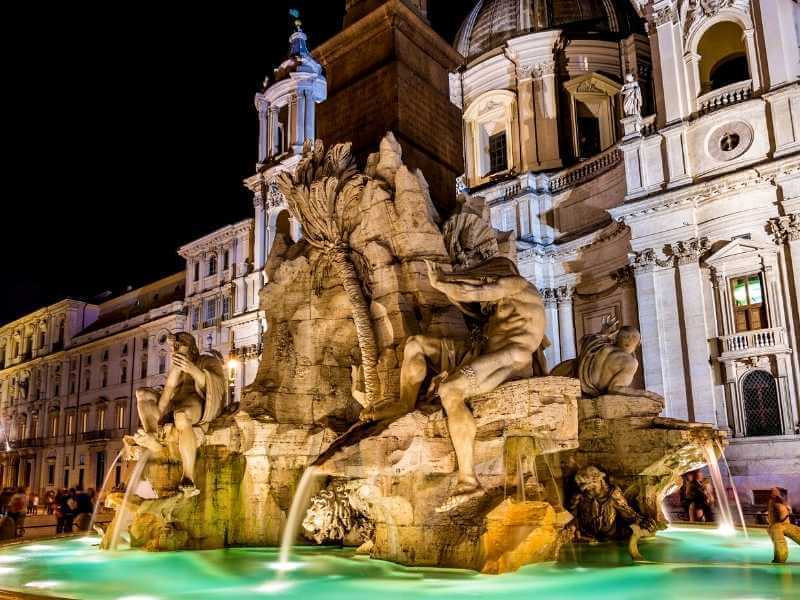
The fountain symbolizes the then-known world and Pope Innocent’s claim to rule over the earth. One of the last transmitted hieroglyphic inscriptions, a homage to Domitian, adorns the obelisk. With its history and extraordinary flair, the Piazza is one of the most famous squares in Rome!
Fontana del Nettuno - the fountain of Neptune
The second of the three baroque Renaissance fountains adorn the northern end of the Piazza. Even if the fountain, built around 1570, attracts less attention than the Fountain of the Four Streams, it is still worth taking a closer look at this work of art.
Like the Moor Fountain, the Neptune Fountain was also initially designed by Giacomo della Porta. Della Porta was an apprentice of Michelangelo and was considered a highly talented sculptor. Among other things, he was involved in constructing St. Peter’s Basilica.
During the restoration of Roman water pipes (Aqua Virgo), several connections for further fountains were created shortly before construction began. The Neptune Fountain was once commissioned by Pope Gregory XIII. However, the fountain initially had no sculptures in its first construction phase.
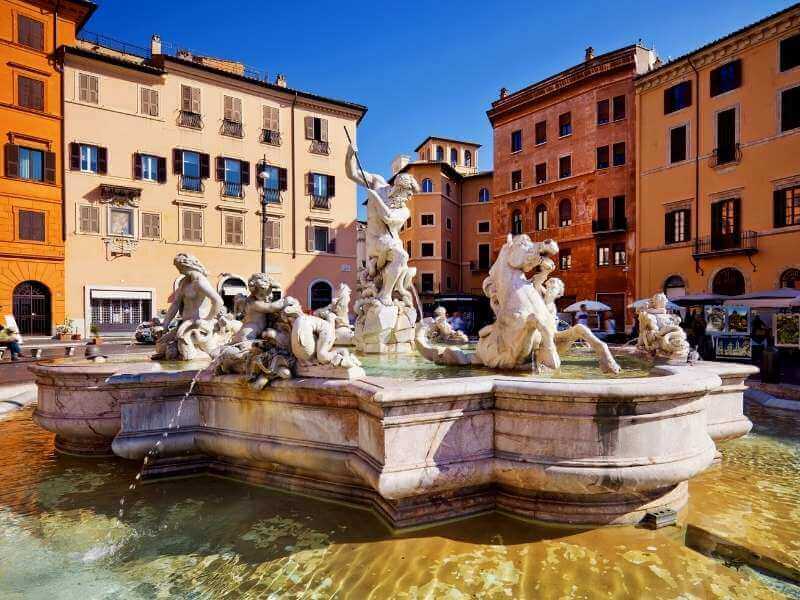
It was not until 300 years later, between 1873 and 1878, that Neptune’s and other mythological sea figures’ statues were added to the fountain. The Piazza had fallen into an imbalance due to the imposing four-current fountain. Antonio della Bitta sculpted Neptune’s figure (stabbing an octopus in the middle of the fountain).
Fontana del Moro - the Moor Fountain
The Fontana del Moro – or Moor Fountain – was also built in the 16th century. Its architect and master builder was Della Porta, a well-known sculptor.
The Renaissance fountain adorning the southern part of the Piazza also looked more spartan in its early days. Initially, only a dolphin and four Roman sea gods were enthroned on the fountain, built around 1575-1576.
In the 17th century, it was once again Bernini who had a hand in the development of the fountain theme. From then on, the central figure is an African man from Ethiopia standing on a conch’s shell and fighting with a dolphin.
Another 200 years later, the Greek sea gods (Tritons) were added. They hold shell horns (gargoyles) in their hands, through which they blow with puffed-out cheeks.
The Cathedral of Sant'Agnese in Agone
A few meters from the Fontana dei Quattro Fiumi is the Cathedral of Sant’Agnese in Agone, built in the 17th century. The church is another highlight of Piazza Navona and an excellent example of Baroque architecture.
The basilica was consecrated in honor of Agnes of Rome, a saint beheaded by a Roman soldier in the Circus. According to tradition, today’s church stands on the exact spot where Agnes suffered martyrdom.
Incidentally, Palazzo Pamphilj, the former residence of Pope Innocent X, is just a two-minute walk from the basilica.
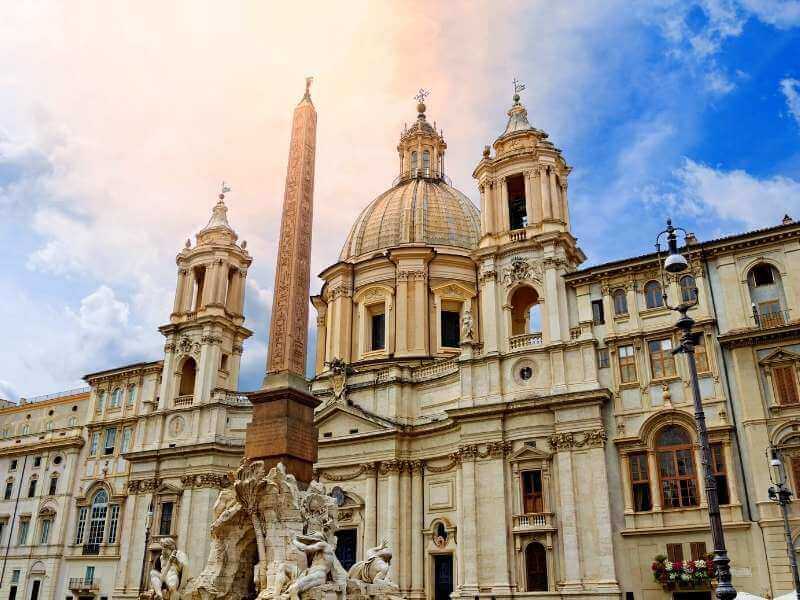
What's nearby? On the map, you can see where Piazza Navona is located:
If you still have a little time left after visiting the Piazza, you can find out more about the history of Rome at the ‘Museo di Roma.’ It is located in Palazzo Braschi and is one of the best museums in Rome.
You will find exciting art treasures by Italian and international artists in today’s art museum. These include, for example, works by Nicola Salvi, who designed the Trevi Fountain in Rome. The museum has over 100,000 paintings, sculptures, drawings, and more.
If you are in Rome around Christmas time, visiting Piazza Navona is particularly recommended. From the beginning of December until Epiphany on January 6, an atmospheric Christmas market is held here annually.
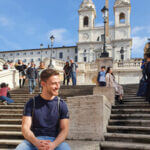
Editor: Sebastian Erkens
Hey and welcome to Rome-Tourist! My name is Sebastian and I travel regularly to Rome, Italy.
On our Rome blog you will get valuable travel tips. If you have any questions about specific tours or sights, feel free to leave us a comment.
These articles may also interest you:
